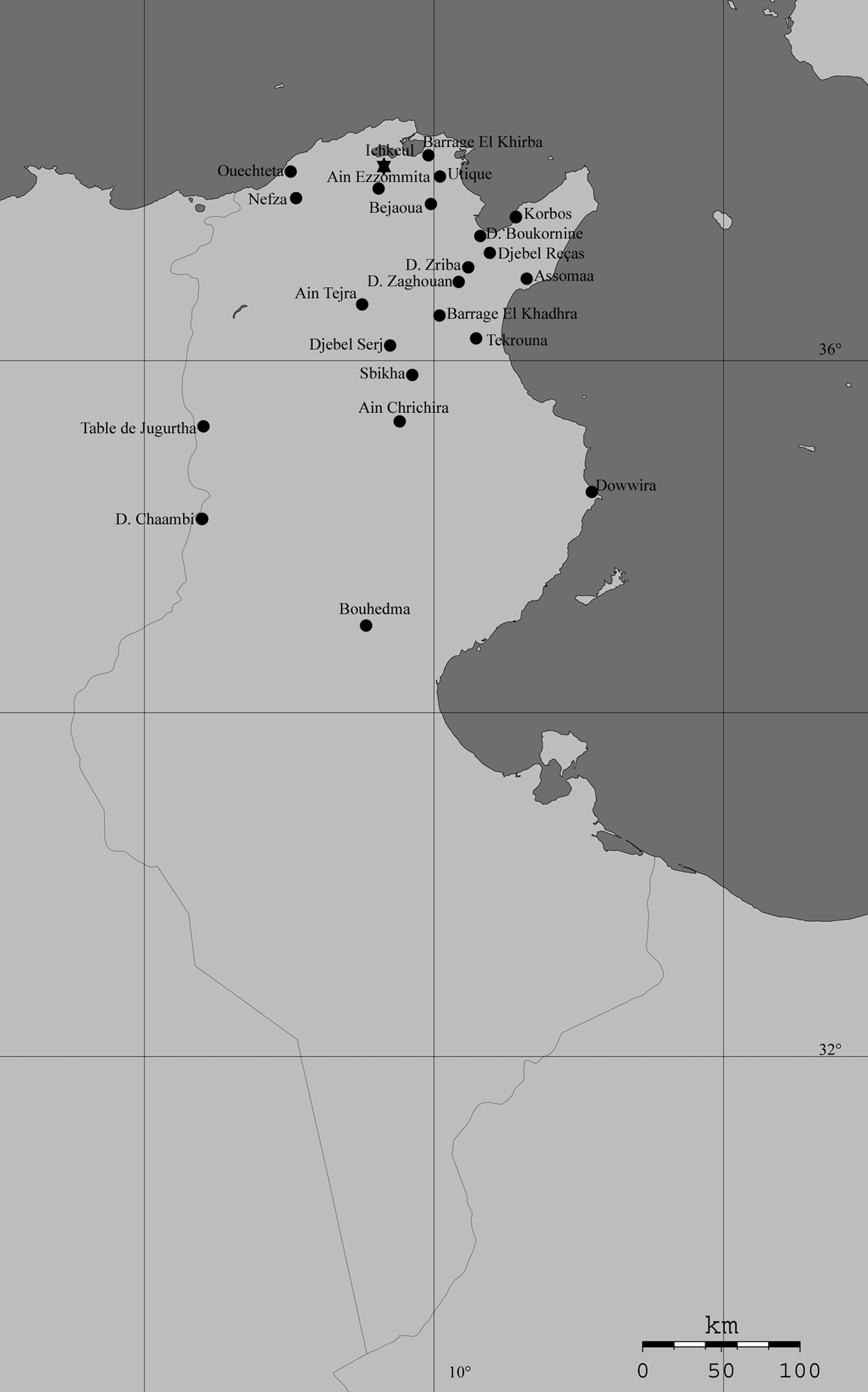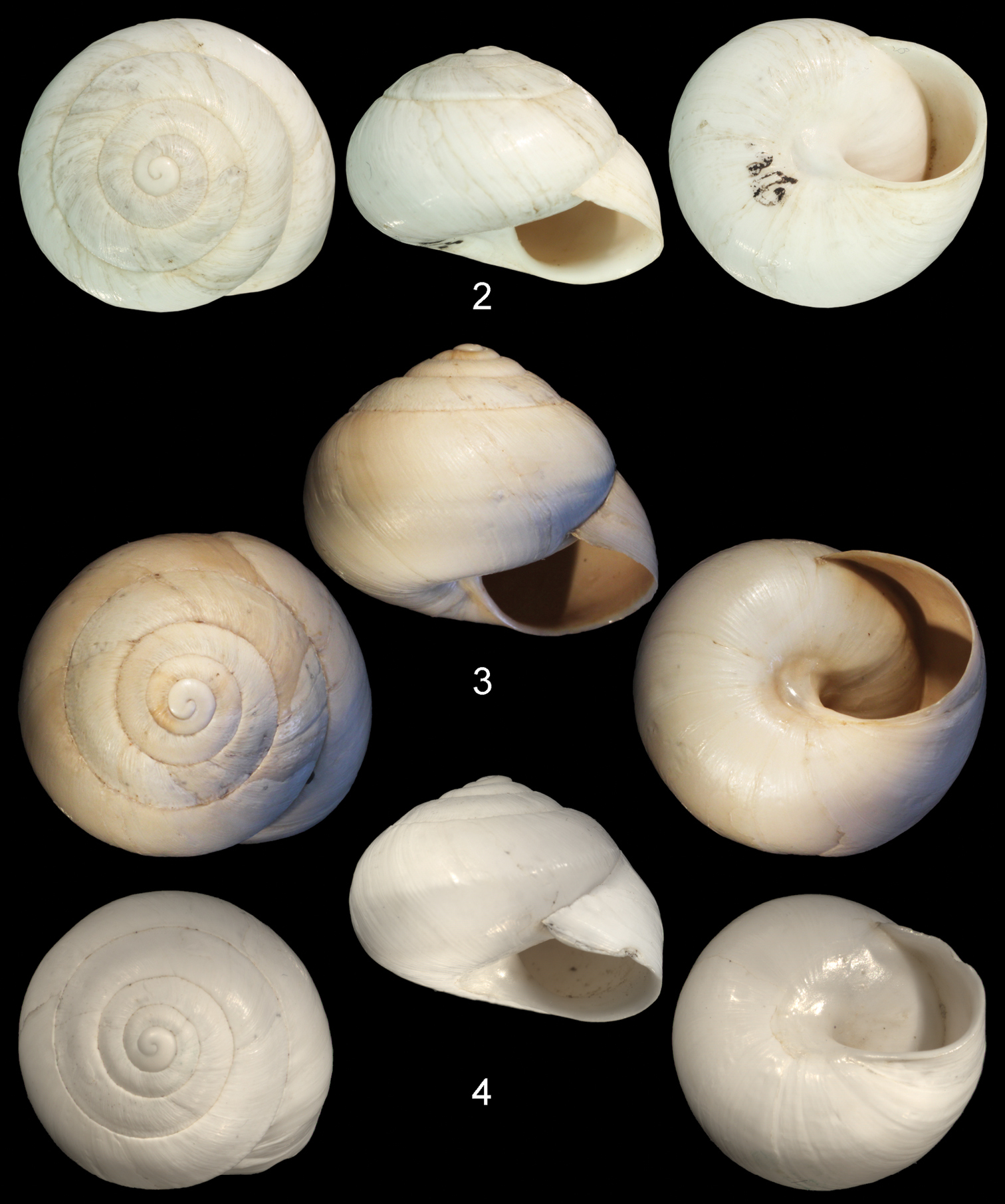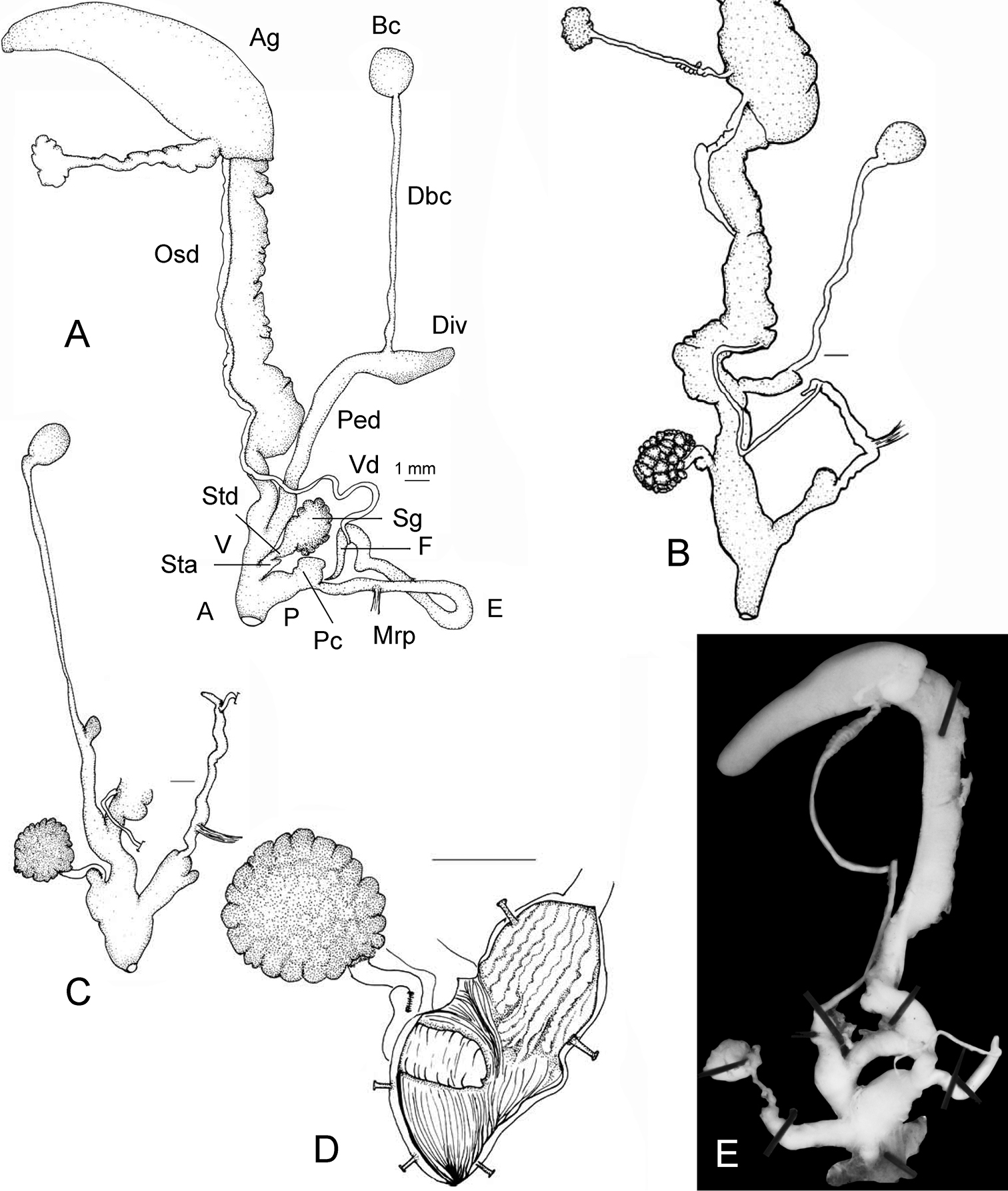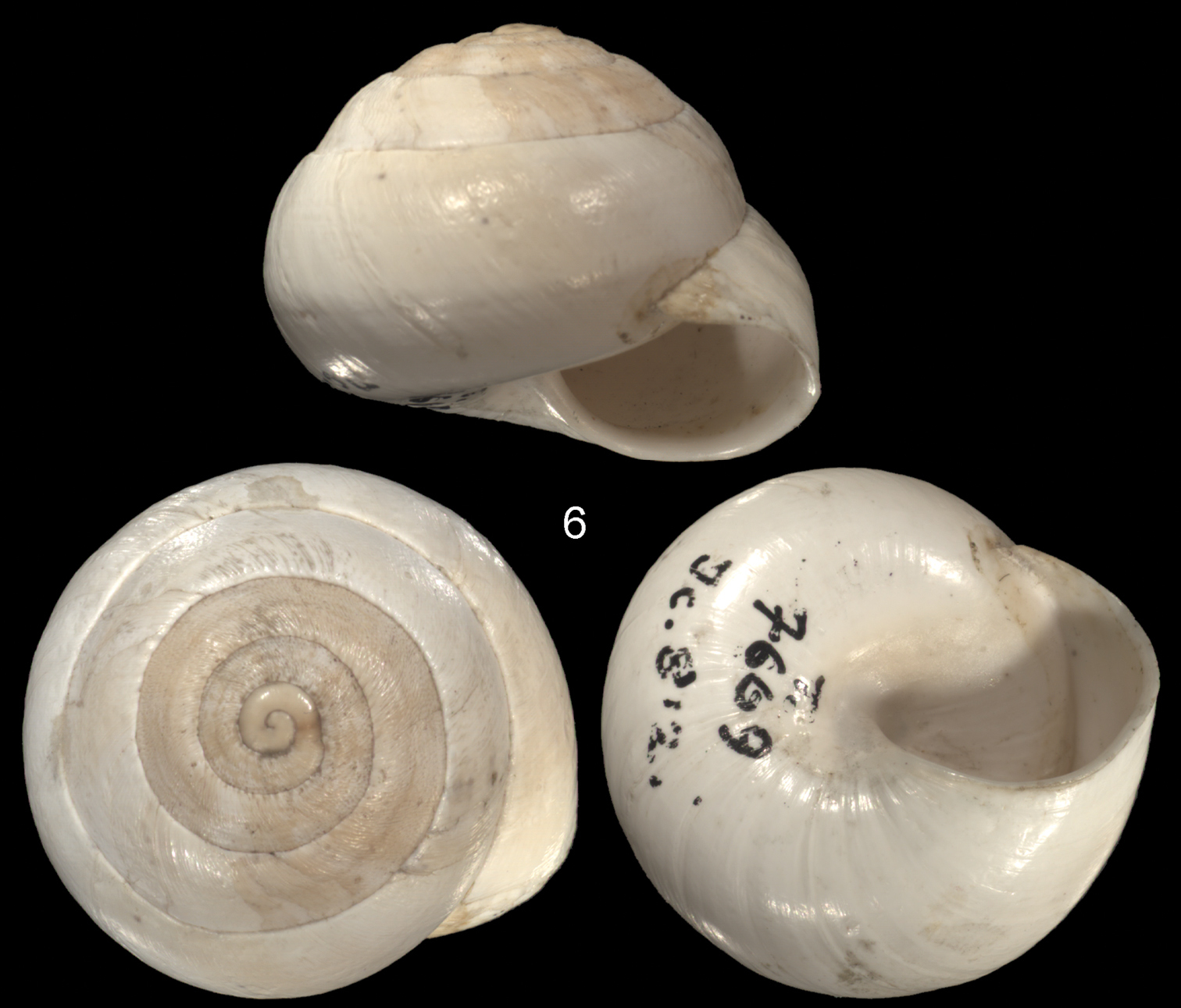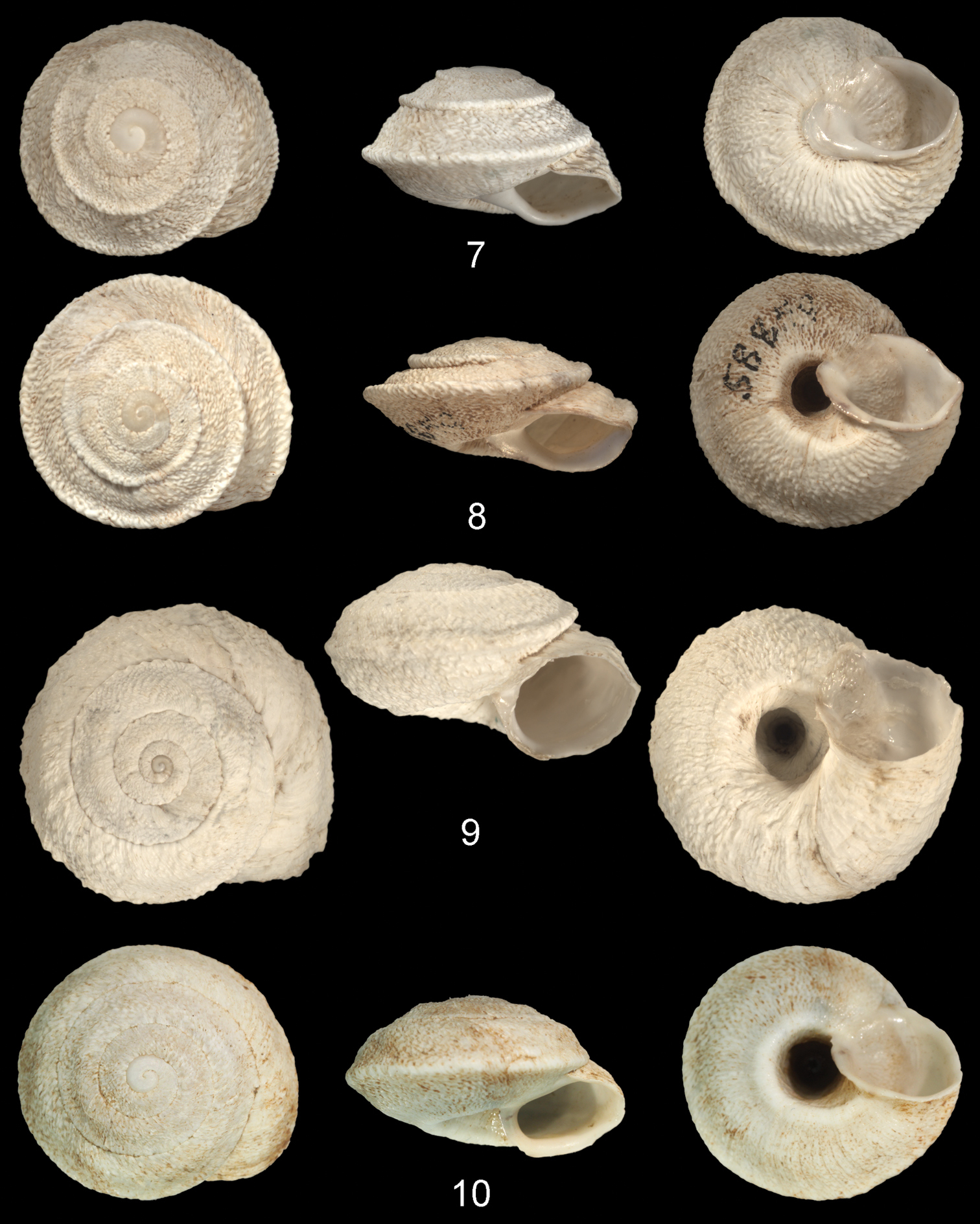






(C) 2011 Intidhar Abbes. This is an open access article distributed under the terms of the Creative Commons Attribution License, which permits unrestricted use, distribution, and reproduction in any medium, provided the original author and source are credited.
For reference, use of the paginated PDF or printed version of this article is recommended.
In order to establish an updated checklist of terrestrial gastropod from Tunisia, a revision of the species of Sphincterochilidae is presented, using bibliographic and museum records and the results of our own field work. As a result, only two species, Sphincterochila candidissima and Sphincterochila tunetana, are accepted to occur in Tunisia, and their type specimens are illustrated. The study of the morphological characters of the genital organs of both species clarified their subgeneric affiliation. Comparison of Sphincterochila tunetana with Sphincterochila cariosa from Lebanonshowed that the first has to be classified within the subgenus Albea, and the latter within Sphincterochila s. str.; the subgenus Rima Pallary, 1910 remains in the synonymy of Sphincterochila s. str. Bibliographic records of Sphincterochila baetica and Sphincterochila otthiana from Tunisia could not be confirmed, the latter probably lives close to the border with Algeria.
RésuméDans le but d’établir une liste actualisée des gastéropodes terrestres de la Tunisie, la révision des espèces appartenant à la famille des Sphincterochilidae, basèe sur les études bibliographiques et muséologiques et sur les résultats de nos propres travaux de terrains, a été présentée. Le résultat obtenu montre que deux espèces uniquement, Sphincterochila candidissima et Sphincterochila tunetana, sont trouvées en Tunisie, les types de ces espèces ont été illustrés. L’étude des caractères morphologiques des organes génitaux de ces deux espèces a clarifié leur affiliation subgénérique. La comparaison de Sphincterochila tunetana avec Sphincterochila cariosa, du Liban, montre que la première espèce doit être classifiée au sein du sous genre Albea et la seconde sous le genre Sphincterochila s. str ; le sous genre Rima Pallary, 1910 reste un synonyme de Sphincterochila s. str. Le recensement bibliographique de Sphincterochila baetica et Sphincterochila otthiana de la Tunisie n’a pas pu être confirmé, la dernière pourrait vivre sur la frontière Algérienne.
Sphincterochila candidissima, Sphincterochila tunetana, Rima, taxonomy, anatomy, distribution data
Sphincterochila candidissima, Sphincterochila tunetana, Rima, taxonomie, anatomie, distribution
The systematic position of members of this family has been debated since almost 150 years.
The family Sphincterochilidae is quite specious, its representatives can be found from Morocco throughout northern Africa to Greece, southern Turkey and the Levant area, but also on the Iberian Peninsula, southern France and the southern parts of Italy and Malta. One radiation centre is situated in northwestern Africa, which is inhabited by a variety of conchologically differing shells. In the 19th century,
This article mainly focuses upon the species occurring in Tunisia, but some problematic taxa from neighbouring countries are addressed as well.
Specimens were collected by hand during field studies conducted in Tunisia since 2005. Living animals were drowned in water for 36 to 48 hours and then fixed in 75% ethanol. Animals were dissected under a stereomicroscope using thin pointed watchmakers’ forceps. Anatomical details were drawn using a Wild camera lucida or photographed. Geographic coordinates of the sampling stations were recorded using a GPS, and a map illustrating the distribution of the species found to live in Tunisia is provided. All shell figures are scaled × 3 to provide a comparative aspect.
Key to acronyms used in figures: A – genital atrium; Ag – albumen gland; Bc – bursa copulatrix; Dbc – duct of bursa copulatrix; Div – coecum-like diverticulum; E – epiphallus; Osd – ovispermiduct; Pc – penial coecum; Ped – pedunculus; Mrp musculus retractor penis; Sg – stimulator gland; Sta – stimulator appendix; Std – stimulator duct; V – vagina; Vd – vas deferens.
Acronyms of collections studied: MHNG – Musèum d’Histoire Naturelle Genève; NEUB – private collection E. Neubert, Badenweiler; NHMW – Naturhistorisches Museum Wien; NMBE – Naturhistorisches Museum der Burgergemeinde Bern; SMF – Naturmuseum Senckenberg, Frankfurt.
Systematicshttp://species-id.net/wiki/Sphincterochila_candidissima
Figs 1–4, 5Acandidissima: syntype NHMW 14810, D = 17.95 mm [no original label left, type locality: France, «en Provence et dans le Comtat»; maxima: not identifiable in MHNG; tunetana: MHNG 3896, D= 20.0 mm.
Bizerte: Aïn Ezzommita, N 36.87628, E 9.64936, 23.12.08, coll. Abbes/8; Barrage El Khadhra, N 36.16681, E 10.06214, 14.12.08, coll. Abbes/4; Barrage El Khirba, N 37.16354, E 10.0955, 21.02.08, coll. Abbes/6; Utique, N 37.04007, E 10.03244, 02.03.05, coll. Abbes/9; Nabeul: NEUB 02879, Wadi NE of the city, 36°28'N, 10°45'50"E, 26.-31.12.1993, leg. B. & R. Kinzelbach; Ariana, Djebel Bejewa, N 37.03027, E 10.027040, 11.04.08, coll. Abbes/12; Ichkeul National Park, N 37. 11255, E 9.34953, 04.03.07, coll. Abbes/7; Tunis: NEUB 02878, Tunis, 20 km S of Hamamet, 02.03.1993, leg. J. Gugel; Ben Arous: Djebel Boukornine, N 36.4122, E 10.2125, 4.01.07, coll. Abbes/8; Djebel Reças, N 36.59382, E 10.3194, 09.10.08, coll. Abbes/5; Nabeul: Assomaa, N 36.52552, E 10.77991, 04.02.09, coll. Abbes/3; Korbos, N 36.82950, E 10.57071, 03.02.09, coll. Abbes/8; Zaghouan: Djebel Zaghouan, N 36.37543, E 10.11868, August 2008, coll. Abbes/9; Djebel Zriba, N 36.37, E 10.11, 20.08.08, coll. Abbes/1; Beja, Nefza, N 97.0041, E 9.08434, 4.4.05, coll. Abbes/2; Jendouba, Ouechteta, N 36.96445, E 9.01706, 24.12.08, coll. Abbes/4; El Kef: Djebel Boujeber, N 35.73791, E 8.27292, 26.12.08, coll. Abbes/3; Sousse, Tekrouna, N 36.085749, E 10.182551, 25.08.2008, coll. Abbes/2; Siliana: Ain tejra, N 36.26, E 9.43, 07.11.08, coll. Abbes/16; Kairouan: Aïn Chrichira, N 35.63908, E 9.80950, 14.12.08, coll. Abbes/9; Sbikha, N 35.98503, E 10.03106, 14.12.08, coll. Abbes/17; Djebel Serj, N 36.04555, E 9.63311, 28.12.08, coll. Abbes/2; Mehdia, Dowwira, N 35.26905, E 11.09773, 19.03.09, coll. Abbes/4; Sidi Bouzid: Bouhedma National Park, N 34.185722, E 9.245520, 11.05.08, coll. Abbes/10; NEUB 02875, Jebel Bou Hedma, 15-18.03.1993, leg. J. Gugel; NEUB 02876, Sabkhat Mecheguig, ca. 50 km S Kairouan, 02.03.1993, leg. J. Gugel; Kasserine: Djebel Chaambi, N 35.10139, E 8.40486, 30.11.08, coll. Abbes/8; Table de Jugurtha, 20.05.09, coll. Abbes/11; Kebili: NEUB 02874, big erg close to Ksar Rhilane, 32°59'N, 9°38'E, 09.03.1993, leg. J. Gugel; NEUB 02880, Kebili, 30 km S of the city, 33°29'N, 9°02'E, 12.03.1993, leg. J. Gugel; Tataouine: NEUB 02877, Tataouine, 32°56'N, 10°27'E, 05.03.1993, leg. J. Gugel; NEUB 02881, Gouvernorat de Tataouine, Ramadah, 32°19'N, 10°24'E, 05.03.1993, leg. J. Gugel.
Shell medium sized, helicoid, globose, shell walls thick, external surface slightly wrinkled, last whorl rounded, aperture rounded, umbilicus closed.
(Figs 2–4). Shell medium sized, helicoid, globose, spire slightly depressed; shell colour white; protoconch consisting of two smooth whorls; shell walls thick, teleoconch of six nearly flattened whorls, last whorl large, rounded and sometimes inconspicuously keeled and slightly descending below the periphery of the shell; suture shallow to moderately deep; upper teleoconch surface smooth or with fine irregularly shaped wrinkles; aperture dorsoventrally depressed; peristome discontinuous, only slightly thickened; umbilicus closed by a thick reflection of the columellar peristome. — Measurement (n = 20). H = 17.3 mm ± 2.46; D = 20.57 mm ± 1.33.
(Fig. 5A). Penis thick with a short and blunt penial coecum, epiphallus a long and cylindrical slender tube reaching 4 × the length of the penis, penial papilla missing; flagellum relatively long; Mrp inserts at the distal third of the epiphallus.
Stimulator gland large, stimulator appendix branches off in a basal position; stimulator duct short, pointing into the large genital atrium with a small papilla.
Vagina very short and slender; pedunculus reaching half of the lenght of the whole bursa copulatric complex, diverticulum short and thickened, bursa copulatrix a well rounded vesicle.
This is a species of western Mediterranean distribution (
The species Sphincterochila baetica (Rossmässler, 1839), which was described from Spain (between Almeria and Venta del Pobre) has been reported for Northwestern Africa from Morocco to Tunisia (
The morphological details of the genital organs of dissected specimens from Tunisia compare very well with those presented by
Distribution of Sphincterochila species in Tunisia ● Sphincterochila candidissima (Draparnaud, 1801) ★ Sphincterochila tunetana (Pfeiffer, 1850).
Sphincterochila candidissima (Draparnaud, 1801) 2 syntype ex NMHW, France, probably from the Provence 3 syntype of Leucochroa baetica var. tunetana Letourneux & Bourguginat, 1887, MHNG 3896, Tunisia, Guelaat es Snam 4 NMBE, Ain Tejra, 07.11.2008, leg. I. Abbes.
Anatomical details. A Sphincterochila candidissima, situs of genital organs. B–D Sphincterochila tunetana. B C situs of genital organs of two specimens D Detail stimulator gland showing the large stimulator papilla pointing into the atrial lumen. – Figs A–C at the same scale. Figure 5E. Sphincterochila cariosa (Olivier, 1801). Situs of genital organs (shell illustrated in Fig. 10); length of complete situs 14.9 mm.
http://species-id.net/wiki/Sphincterochila_tunetana
Figs 1, 5B–D, 7, 8No type specimens could be traced in any larger museum collection with holdings of specimens from the Pfeiffer collection. One syntype was figured by Pfeiffer in 1853 (“in der Gegend von Tunis, aus H. Cuning’s Sammlung”), another without reference to the collector by
Ichkeul National Park 13.02.08, coll. Abbes/15.
Shell nearly flat or with slightly elevated spire, upper shell surface with very coarse sculpture; last whorl keeled, aperture lenticular; umbilicus open to completely closed.
Shell medium sized, nearly flat or with slightly elevated spire; shell with 4 ½ flattened and regularly growing whorls; white yellowish in colour; suture shallow; upper shell surface with coarse and oblique, rib-like sculpture, lower shell surface with irregular wrinkles; last whorl sharply keeled; aperture lenticular; peristome discontinuous, parietal callus lacking; lip slightly thickened, often slightly reflected on the lower and columellar side; umbilicus wide and open, surrounded by a cord like ridge; there are specimens where the columellar reflection completely obscures the umbilicus.
(n = 15). H = 8.5 mm ± 1.37; D = 16.58 mm ± 0.79.
Penis thick club-shaped, with a short penial coecum, epiphallus long reaching only twice the length of the penis, penial papilla missing; flagellum short; musculus retrator penis inserts at the distal third of the epiphallus.
Stimulator gland very large, stimulator appendix branches off in a basal position; stimulator duct short, pointing into the genital atrium with a large papilla (Fig. 5D).
Vagina very short and slender; pedunculus short, reaching a third or even less of the lenght of the whole bursa copulatric complex, diverticulum short to reduced, bursa copulatrix a well rounded vesicle.
This species was only reported from Tunisia by
At first glance, Sphincterochila tunetana may be confused with a species of the Hygromiidae, Helicopsis (Xeroleuca) degenerans Mousson, 1872, from Morrocco (Fig. 9) because of the depressed shape of the shell, the magnificent sculpture, and the open umbilicus. However, the small-sized protoconch of Helicopsis degenerans is a good character to discriminate it from Sphincterochila tunetana. Affiliation of the latter species to the Sphincterochilidae was already suggested by
The differences in morphology of the genital organs to Sphincterochila candidissima are quite large: Sphincterochila candidissima has a much longer epiphallus and flagellum, and the diverticulum in Sphincterochila tunetana seems to be reduced, and its pedunculus is considerably shorter than in Sphincterochila candidissima.
Sphincterochila baetica (Rossmässler, 1839), syntype SMF 7669, Spain, between Almeria and Venta del Pobre, coll. Rossmässler (= Orig. Icon. 812).
7, Sphincterochila tunetana (Pfeiffer, 1850), NMBE, Tunisia, Ischkeul, 08.01.2004, leg. I. Abbes 8 Sphincterochila tunetana (Pfeiffer, 1850), SMF 58859, Achkeul [= Ischkeul], ex coll. Pallary 9 Xeroleuca degenerans (Mousson, 1876), syntype ZMZ 502781, Morocco, “Ain Umest westlich der Maroccoebenen, coll. Mousson ex Fritsch 1873” 10 Sphincterochila cariosa (Olivier, 1801), Libanon, Deir el Kamar, 33.7°N, 35.59°E, leg. N. Sayar, 4.10.2009 (shell of anatomically investigated specimen).
The history of the subgeneric classification of Sphincterochila Ancey, 1887 was demonstrated by
Already
According to Schileyko’s classification of 2004, the lenticular shape of the shell and the open umbilicus automatically qualifies Sphincterochila tunetana for inclusion into the subgenus Rima. For this reason, we dissected a specimen of Sphincterochila cariosa from the vicinity of Beirut (Lebanon) to compare the morphology of its genital organs to that of Sphincterochila tunetana. Our investigation clearly showed that Sphincterochila tunetana has a thin-walled “sheath” (Fig. 5B-D), while in Sphincterochila cariosa it is clearly thickened (Fig. 5E). As a result, Sphincterochila tunetana has to be classified within Albea, while Sphincterochila cariosa stays in Sphincterochila s. str. as suggested by Forcart. However, his classification suffers from the fact that he could not cover the whole radiation of the family, hence his system requires a serious reconsideration. The use of Cariosula as a separate subgenus could not be addressed here because of lack of specimens (the species does not occur in Tunisia) and is left for a comprehensive taxonomic revision of the family.
On records of other nominal taxa of Sphincterochilidae from TunisiaAnother species recorded by
Sphincterochila candidissima is one of the most widespread species of the family and was most likely introduced to France. However, it is frequently recorded from NW Africa to Spain, and this probably represents the natural distribution area of the species. Within this range, shell morphological variation may be found as can be seen in southern Tunisia, where the population of Djebel Bouhedma includes specimens with higher and more conical shells if compared to populations from northern Tunisia. By contrast, Sphincterochila tunetana has a very restricted geographic range and seems to be endemic to the Ichkeul National Park region.
Many nominal sphincterochilid species from NW Africa have to be reconsidered. For example, Sphincterochila maroccana (Pallary, 1910) looks very similar to Sphincterochila candidissima, while some nominal species like Sphincterochila cariosula (Michaud, 1833), Sphincterochila octinella (Pechaud, 1883), Sphincterochila rugosa (Pallary, 1900), and Sphincterochila corrugata (Pallary, 1917) show a superficial shell resemblance with Sphincterochila tunetana. But as shown in this paper, shell resemblance does not necessarily reflect a phylogenetic relationship, and more basic revisional work is required to entangle the taxonomy and nomenclature of this family as a whole.
We thank the curators who gave access to collections under their care or who provided us with type specimens or gave information on the whereabouts of specimens. Other colleagues helped us with valuable additions and comments on the paper (in alphabetical order): Jon Abblett (NHM London), Anita Eschner (NHMW), Yves Finet (MHNG), Ronald Janssen (SMF), and Sankuryie Pye (NMSZ Edinburgh). We are extremely grateful to Michel Bariche and Nancy El-Sayar (American University of Beirut) for providing us with a preserved specimen of S. cariosa from Lebanon. The Natural History Museum of the Burgergemeinde Bern generously payed the expenses of the stay of I. Abbes in Berne in 2009.
The senior author was supported by a grant of the Tunisian “Ministère de l’enseignement supérieur et des recherches scientifiques” to visit the Senckenberg Museum, the Naturhistorisches Museum der Burgergemeinde Bern, and the Museum d’Histoire Naturelle de Genève.
The senior author is very grateful to “La direction générale des forêts, ministère d’Agriculture” to permit access to the National Parks and Natural Reserves, and to those people who helped her during the field work (in alphabetical order): Aymen Nefla, Mouldi Kharroubi and Ridha Ouni (Association amis des oiseaux, Tunisia).
